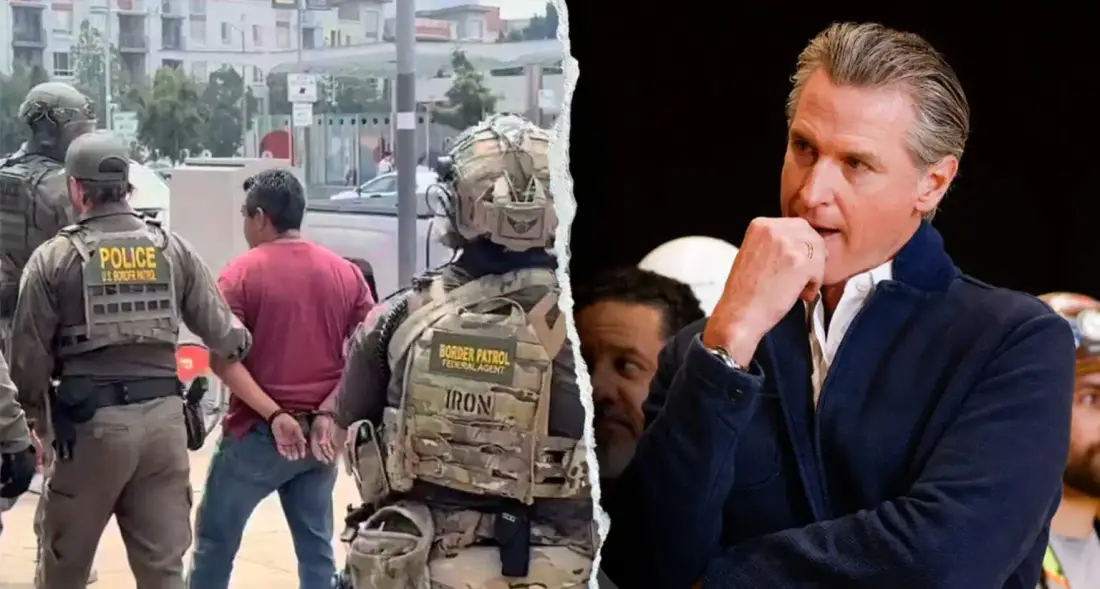The sun had barely risen over Dallas when the sound of gunfire broke the stillness of the morning. For those nearby, the sharp cracks echoed like a reminder that America’s debates over law, justice, and borders no longer live only in congressional halls or late-night talk shows. They spill into real life, into communities, and sometimes—into bloodshed.
Hours earlier, on the opposite side of the country, another drama was unfolding. California Governor Gavin Newsom, a man who has carefully positioned himself as a national Democratic figure and possible 2028 contender, sat across from Stephen Colbert. The studio lights were warm, the crowd lively, and the questions familiar. Yet what Newsom said that night would take on an eerie resonance before the next sunrise.
A Night of Words, A Morning of Violence
On Colbert’s couch, Newsom painted a picture of Immigration and Customs Enforcement (ICE) that sounded more like a scene from a dystopian film than the description of a federal agency. He accused masked men of jumping from unmarked cars, of vanishing people without oversight or due process. His tone was fiery, his body language sharp, and the message unmistakable: ICE was not simply enforcing immigration law; it was, in his telling, engaged in authoritarian actions targeting “black and brown communities.”
“People disappearing. No due process. No oversight. Zero accountability,” he declared. “That’s happening in the United States of America.”
For his liberal audience, the words drew applause. For critics, they were reckless at best, inflammatory at worst. And for the officers of ICE, who wear protective gear and cover their identities after being doxxed and harassed by activists, the remarks sounded like another attempt to turn them into villains in the national drama over immigration.
Then came dawn in Dallas.
The Attack at the ICE Facility
Around 7:30 a.m., as ICE officers prepared a routine transfer of detainees at a detention facility in Dallas, shots rang out. Authorities described a gunman attempting to force entry through the sally port, opening fire as officers moved. In the chaos, three people were shot, two fatally, before the attacker died from a self-inflicted wound.
Homeland Security Secretary Kristi Noem confirmed the grim details.
“There was a shooting this morning at the Dallas ICE Detention Facility,” she said in a statement. “Details are still emerging but we can confirm there were multiple injuries and fatalities. The shooter is deceased by a self-inflicted gunshot wound. While we don’t know motive yet, we know that our ICE law enforcement is facing unprecedented violence against them. It must stop.”
For ICE families across the country, the words carried a heavy weight. These were not abstract debates over immigration policy. These were husbands, wives, fathers, and mothers walking into danger every day. And now, yet another facility had come under fire.
Political Reactions Pour In
As news of the shooting spread, reactions from Washington and beyond flooded social media. Vice President JD Vance posted bluntly on X:
“The obsessive attack on law enforcement, particularly ICE, must stop. I’m praying for everyone hurt in this attack and for their families.”
Texas Senator Ted Cruz, too, issued a statement:
“My team and I are closely monitoring the situation at the ICE Detention Facility in Dallas. We are praying for the swift recovery of those injured, and we are deeply grateful to the brave first responders who rushed to the scene.”
Behind the statements was a growing unease: had rhetoric like Newsom’s, repeated and amplified by national media, made it easier for some to justify violence against ICE?
https://x.com/martinwalsh__/status/1970848406265622884?ref_src=twsrc%5Etfw%7Ctwcamp%5Etweetembed%7Ctwterm%5E1970848406265622884%7Ctwgr%5Eb44ba2aa019825528fefab292e10524af949e0c8%7Ctwcon%5Es1_c10&ref_url=https%3A%2F%2Fconservativebrief.com%2Fnewsom-ice-95429%2F
Newsom’s Rhetoric Under Scrutiny
Newsom’s appearance on Colbert was not unusual. Governors, senators, and presidential hopefuls often use late-night platforms to polish their image with younger, left-leaning audiences. But his language stood out—harsh, uncompromising, and personal.
He described ICE operations as if they were clandestine kidnappings: masked men, unmarked vans, disappearances. He dismissed critics who said he was exaggerating. “Bullshit we’re being hyperbolic,” he snapped.
For conservatives, it was textbook gaslighting. They argued that Newsom deliberately ignored the reality: ICE officers operate under court-issued removal orders, often targeting individuals with criminal records. They cover their faces not because they are hiding from oversight, but because activists—including some Democratic lawmakers—have doxxed them, putting their families at risk.
To ICE supporters, Newsom’s framing wasn’t just wrong—it was dangerous. It painted officers as villains, stripping away their legitimacy and, potentially, emboldening those who would see violence against them as justified resistance.
A Pattern of Attacks
The Dallas shooting was not an isolated event. In recent years, ICE facilities have become flashpoints for protest, vandalism, and, increasingly, violence. Activists have targeted detention centers with demonstrations, some peaceful, others destructive.
In 2019, an armed man attacked an ICE facility in Tacoma, Washington, with firebombs. In 2020, during nationwide protests, ICE buildings were besieged in cities across the country. Now, in 2025, the violence has escalated again.
Each time, political rhetoric has loomed large. Critics argue that when national leaders depict ICE as kidnappers or racists, they contribute to a climate where violent action feels righteous to extremists. Supporters counter that highlighting abuses is necessary, and that violence is the responsibility of individuals, not rhetoric.
The Fallout for Newsom
For Gavin Newsom, the timing could not be worse. As he quietly builds a national profile ahead of 2028, every word he speaks is measured not just as a governor, but as a potential presidential candidate.
This week alone, his team sparked controversy with a cryptic post aimed at Homeland Security Secretary Kristi Noem: “Kristi Noem is going to have a bad day today. You’re welcome, America.” To critics, it sounded like a threat. To supporters, it was a jab at anti-immigration policies. To undecided voters, it may simply look reckless.
Combined with his Colbert remarks and the Dallas attack, the optics are damning. Republicans are already seizing the moment, framing Newsom as a radical who smears law enforcement while violence rises.
The Broader Immigration Debate
Beyond politics, the episode underscores the deep fractures in America’s debate over immigration and law enforcement. To some, ICE represents cruelty and injustice. To others, it is the thin line protecting the nation from lawlessness.
This divide is not new, but it has grown sharper in recent years. Sanctuary states like California have clashed repeatedly with federal authorities. Cities have passed ordinances restricting cooperation with ICE. Meanwhile, border states have pleaded for stronger enforcement and relief from the surge of illegal crossings.
Against this backdrop, Newsom’s rhetoric—and the Dallas attack—become more than isolated events. They are symbols of a country struggling to reconcile security with compassion, law with humanity, sovereignty with global responsibility.
Looking Ahead: The Stakes of 2028
As the 2028 race begins to take shape, immigration will remain a central fault line. Vice President JD Vance has already positioned himself as a hardline defender of border security and ICE. Newsom, if he emerges as the Democratic nominee, will likely be painted as the opposite: a sanctuary-state governor who vilified law enforcement.
Incidents like Dallas will be used as case studies in campaign ads, stump speeches, and debates. The question will not just be about policies, but about words—about whether leaders’ rhetoric fuels unity or division, peace or violence.
Conclusion: Words Have Consequences
In the end, America finds itself caught between two stark realities. On one hand, there is the undeniable need for strong borders, clear laws, and dedicated officers willing to enforce them. On the other, there is the human cost of enforcement—families separated, communities fearful, and policies that many view as unjust.
Leaders like Gavin Newsom walk a narrow path, balancing empathy with responsibility, rhetoric with reality. Yet when words cross into exaggeration or vilification, they risk more than applause—they risk lives.
The shots in Dallas were a tragic reminder that in today’s America, rhetoric does not stay on stage. It travels. It lands. And sometimes, it explodes into violence.
As the nation heads toward another pivotal election cycle, the lesson may be simple but sobering: in a divided country, words are never just words. They are sparks. And sparks, in the wrong moment, can set a nation ablaze.

Adrian Hawthorne is a celebrated author and dedicated archivist who finds inspiration in the hidden stories of the past. Educated at Oxford, he now works at the National Archives, where preserving history fuels his evocative writing. Balancing archival precision with creative storytelling, Adrian founded the Hawthorne Institute of Literary Arts to mentor emerging writers and honor the timeless art of narrative.
